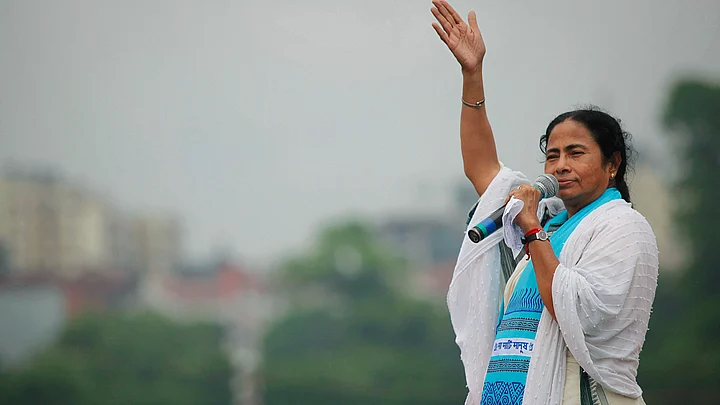Before voting got underway in West Bengal on 4 April, the threat of violence loomed large over a state which has historically witnessed widespread electoral malpractice and fraud, besides murder, mayhem and bloody carnage.
The scale of violence and attendant malpractices in the ongoing assembly elections are nowhere near what Bengal experienced when the CPI(M)-led Left Front was in power. But the four phases of a prolonged election season have so far witnessed sporadic violence, including crude ways in which the ruling Trinamool Congress, up against a formidable CPI(M)-Congress alliance, has sought to strike fear among voters.
Reports suggested that at some places which went to the polls in two parts of the first phase – 4 and 11 April – TMC musclemen successfully prevented people from exercising their franchise. In many other constituencies in Birbhum district, for instance, hooligans backed by lower level ruling party activists resorted to intimidating tactics to scare voters from queuing up.
An Indecisive Election Commission
For its part, the Election Commission, headed by retired IAS officer Syed Nasim Ahmad Zaidi, appeared to be neutered. They were unable to act firmly and found to be dithering when taking decisive steps could have gone a long way in reinstating public faith in an institution which has, to be fair to it, evolved laws and rules that made free and fair conduct of elections a norm across the country.
But Bengal has always been a different animal when it comes to electoral violence which, more often than not, would be gratuitous. The homes of people believed to be supporters of parties other than the ruling dispensation would be torched, hacking to death dissidents or supporters of opposition parties or maiming them was the order of the day.
Bengal’s Past Experience
Extreme political violence was in plain sight in Nanur (2000), in Birbhum, Nandigram (2007) in East Midnapore and Keshpur and Garbeta in West Midnapore among other bloody sites of TMC and CPI(M) clashes. During its heyday, the CPI(M) would employ “labour boycotts” and “social boycotts” to ostracise people who dared to go against the “Party”. In towns and villages, the CPI(M) local committee was viewed as the basic unit of political terror.
Once the CPI(M) was ousted from power in 2011, it did not take long for the TMC to appropriate the usual time-tested means of violence. The only difference was that the TMC, bolstered by sundry thugs who switched their loyalty to Mamata Banerjee’s party, would issue the threats openly. And carry them out surely and without qualms. The Trinamool Congress became the “party”, the new Big Brother.
While violence is integral to Bengal’s politics, its practice and unleashing is subject to two conditions: either the party in power is doing exceedingly well, or when its chips are down. It is not that the TMC was a benign organisation alien to violence in 2011. It’s massive victory that steamrolled the CPI(M) was not simply an outcome of a mandate in which the people voted freely against the Marxist party.
Trinamool’s Contribution
There were instances when the TMC took recourse to the very means for which the CPI(M) became a hated and much-reviled organisation. In the 2014 general elections, TMC orchestrated violence, accompanied by electoral fraud, especially in the tribal-dominated districts in western Bengal, reached a nadir. Alongside the perpetration of violence against its political opponents, the lower level leadership, as also some in the upper rung, took to unbridled corruption.
Lower rung TMC activists, such Kazi Nurul Huda from Rooppur in Birbhum admitted candidly that “making money by looting” from government-sponsored projects, such as the Mahatma Gandhi National Rural Employment Guarantee (MGNREGA) and fisheries schemes was rampant in his district. Likewise, money is skimmed from small road-laying projects across Bengal’s villages.
Add to this the crores that went into the TMC’s coffers through the Saradha Group’s phoney chit fund schemes that cheated hundreds of thousands of ordinary families across the state. Needless to say, the distribution of the spoils of power also caused upheavals within the TMC, causing violent intra-group rivalries in the districts.
Mamata no Messiah
When the people of Bengal threw out the CPI(M) and ushered in the Trinamool Congress in 2011, they heaved a collective sigh of relief that quotidian violence would be a thing of the past. Mamata was seen as the messiah of the downtrodden, of the caring leader who would follow the law to rid the state of lawlessness and take to equal redistribution of resources. She herself promised a new social order in which there would be badalav (change) but no badlaa (revenge). Her promise today sounds hollow.
Among other things, violence in Bengal is a cultural artefact and a traditional behaviour pattern among political parties that periodically becomes a cataclysm under certain social and political conditions. But when political parties in power take to violence, especially during make or break elections, it is almost a sure sign that it is not only beleaguered for having done little to improve the economic conditions of the people, but also fighting with its back to the wall.
This stems from fear – the fear of losing power, the fear of losing the pecuniary benefits attached to power and the fear of a public backlash in the form of a no-confidence vote. For the TMC, much like the CPI(M) in the past, the practice of violence is linked to its predatory politics.
